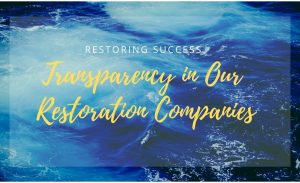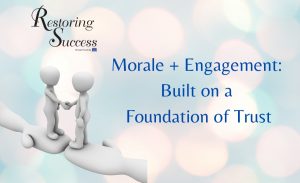
One of the greatest challenges in our industry has been finding “good” people. Once you do find a good one, they still likely need training and on-boarding, the next challenge. The year 2020 will go down in history as the year of challenges and it is in the spirit of overcoming these obstacles that rapid developments and opportunities present themselves. Training, employee development, and on-boarding solutions that are now at the forefront of our industry and may be the keys to overcoming many of our age-old challenges including but not limited to:
- Technical Training
- Soft Skills, Operations, Management Training
- Employee Engagement and Development
- On-boarding
- Accessibility of Training
- Time/Resources/Money
- And more
The Journey of the Restoration Technical Institute
As I reflect on the last six months and how it has impacted training for the Restoration Technical Institute, the individuals, and the companies in our industry, I cannot help but to think of one of my favorite stories about a farmer, “Good Luck, Bad Luck, Who Knows?”. As events unfold, we do not know what is next, we do not know the end of the story; it’s not a single event that will define an outcome, but rather a series of events.
2018: We began “dabbling” in the world of on-line training. We had long-term goals and visions. However, for the next two years, our focus and development were on our in-person programs and hands-on approaches to training.
February 2020: Our training center was full of cheer as we held packed classes of IICRC WRT (Water Restoration Technician) and IICRC ASD (Applied Structural Drying).
March 2020: We had to cancel five months of classes that were planned more than a year ago. Thankfully, earlier in the year, RTI teamed up with ISSA to provide training and education for the cleaning and restoration industries.
April 2020: RTI recognized that ISSA offers a very robust Online Learning Institute, which is stockpiled with courses and content that is needed by everyone in cleaning and restoration. Although we have been working informally with ISSA for several years, the time came to go to another level. We are now a training partner with ISSA.
ISSA has a history of developing content and certification, with self-paced online learning. CMI, a division of ISSA, offers a high-quality learning management system (LMS) that is full of content and tools to engage subscribers and manage the learning process. Cleaning, disinfection, sales, management, and safety are just a few of the related subject matters that ISSA and their divisions offer. It is with great excitement that we have been given the opportunity to collaborate with and add to the vast amount of resources and expertise available through ISSA and its divisions.
May 2020: As the IICRC adapted, many of our courses became approved for online live stream. We hosted our first online, live-stream water class.
June – September 2020: The last several months have been an amazing whirlwind with the objective of offering accessible and affordable training and resources globally. The highlight reel of the last couple of months includes but is not limited to, what I describe as our continuous learning, adapting, and pivoting to the world, opportunities, and most importantly to the demand and expectations of those we serve:
- LMS Subscription: Working diligently on content and curriculum to serve our industries.
- Instructional Design: Learning about the technology, approaches, and the discipline of instructional design. Collaborating with instructional designers to develop courses and content that are effective for today’s learners.
- Continuously evolving our live offerings both on-line and in person.
- Self-Paced Course Development: Creating content, videos, and courses to present.
Learning Management Systems & Self-Paced Learning
In a Fresh Look at Online Training, you will gain some insight to the general training landscape, the benefits and some tips to utilize the new opportunities available to you and your teams. Although e-learning is not new (in 1924 the first “automatic teacher” was presented), if you have some reservations about the effectiveness of self-paced learning and learning management systems, I defer to many other industries in a variety of disciplines who have successfully utilized this approach and have enjoyed positive outcomes and some statistics:
- eLearning In The Workplace: 7 Statistics That Prove Its Great Value
- Other who have adopted and found success in using e-learning approaches are vast. A few examples:
- Medical
- Military
- Aviation
- Retention: Many sources report an increase in retention from e-learners and many other benefits. Read More: 79 Staggering e-learning Statistics
Events that initially seemed like bad luck for industry training have turned into really, good luck. Learning management systems and self-paced learning are two viable solutions to some of our industry’s greatest hurdles. If you have not experienced these types of training approaches, it is not what one may imagine when you think of a recorded type course or training. It is not just a recorded voice and power point slides. Some of the elements you may see within this realm include but are not limited to:
- Gamification: Content may be presented in interactive ways that help teach and engage the learner.
- Knowledge Checks: Interactive and well-timed knowledge checks are used to engage the learner, give confidence in the understanding of the materials, and reinforce important learning objectives.
- Video Demonstrations: Videos help to mix the media and can be used to communicate and tie together a variety of topics. Video demonstrations are particularly helpful to present practical applications and demonstrate tactile skills.
- Micro-learning: As an approach, you may find content divided into small sections of approximately 10 minutes or less. This approach is getting a great deal of attention based on a variety of results and feedback from learners.
- Experienced instructors guiding learners through curriculum and demonstrations.
- Soon, expect to hear more about virtual and augmented reality as the technology and its availability is rapidly evolving.
The training world is evolving rapidly and could help us all achieve more, Restoring Success.
Originally Published: R&R Magazine Online



 When you own a business, particularly a restoration company, there are a lot of different elements that you have to keep an eye on to
When you own a business, particularly a restoration company, there are a lot of different elements that you have to keep an eye on to 
 Industry restoration software
Industry restoration software






